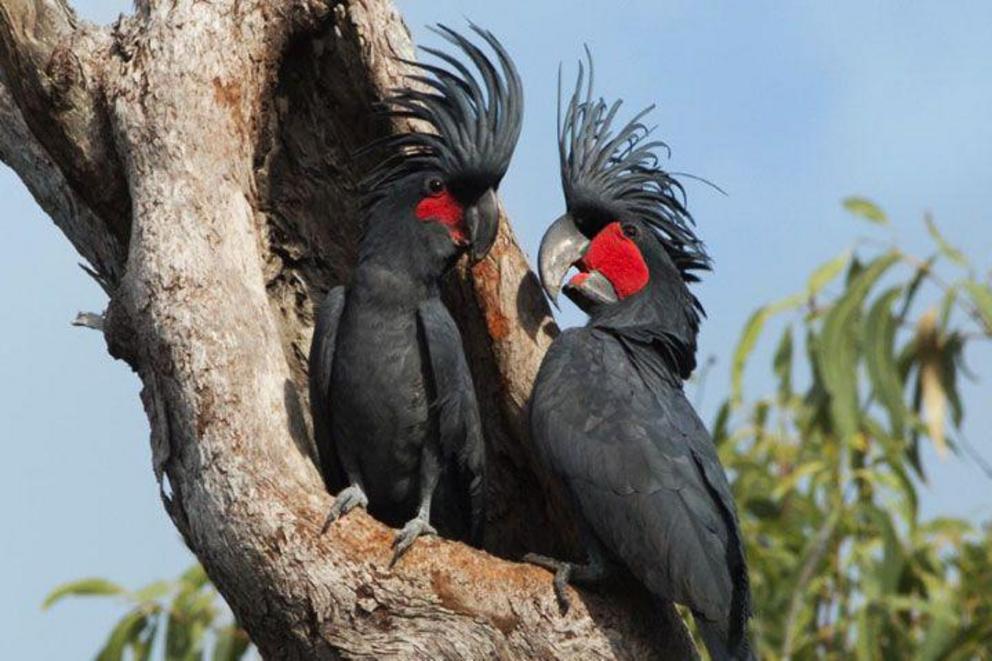Rare 'Ringo Starr' cockatoo faces extinction
... due to habitat loss in Far North Queensland
A rare and beautiful cockatoo, known as the "Ringo Starr" of the bird world, could be extinct in Australia within a decade unless urgent action is taken to protect its habitat in a remote part of Queensland.

It's estimated up to 3,000 of the Palm Cockatoos are left in Australia with the rare bird only found on the tip of Cape York in far north Queensland.(Supplied: The Difficult Bird Research Group)
Key points:
- The Palm Cockatoo is extremely rare and is the only bird in the world that uses a tool musically.
- Researchers are worried the bird will be extinct in a couple of decades due to habitat loss and low reproductive success.
- The cockatoo is currently listed as vulnerable but researchers are building a case to reclassify it as endangered.
The Palm Cockatoo, which can make its own musical instrument, is only found on the top of Cape York in far north Queensland but its numbers are declining rapidly.
Researchers fear the distinctive black bird, which is Australia's largest cockatoo, could soon disappear because its habitat is being lost to mining and land clearing.
Professor Robert Heinsohn from the Australian National University has been studying the Palm Cockatoo since the 1990s and describes it as "one of the spectacles of the bird world".
"They are magnificent large parrots and very ancient ... right from the start of the family tree for parrots ... and they are just incredibly striking to look at," he said.
"They not only look good but are the rock stars of the bird world ... making drumsticks from branches and banging out tunes to attract the bird ladies."
Professor Heinsohn said the Palm Cockatoo is the only bird in the world that uses a tool musically.
"They break off a branch and peel back the bark, they whittle it down to about 30 centimetres and they hold it in their foot and tap on the edge of their nest hollow," he said.
"They have a very good sense of rhythm and different styles of drumming signatures.
"Some males like to come in with a real fast flourish and then they slow down and get into a steady beat, other ones will have a bit of a flourish in the middle of their routine, or some will leave it to the end.
"There are 18 males that we've recorded in action trying to attract a female and they were all different."
Despite the Palm Cockatoo's best efforts to lure mates, Professor Heinsohn said a recent field trip to Queensland's far north showed the bird population had been declining at a rapid rate.
"It's going backwards quite fast, so we're very worried ... we're talking a matter of a couple of decades that we could get to the point of no return if we don't do something now," he said.
Case for endangered classification
The shy and elusive birds live in a number of colonies on both sides of the Cape, more than 10 hours' drive north of Cairns, in small bands of woodland at the edge of rainforest.
The largest flock is found in the Iron Range National Park, north of Lockhart River and there are small clusters of birds at Bamaga on the tip of Cape York and near Weipa on the western side of the Cape.
Professor Heinsohn said the birds were impossible to catch and extremely difficult to study and the best estimate of the total population left in Australia was between 2,000 and 3,000.
The striking birds are currently listed as vulnerable but Professor Heinsohn said he was making a case for that to be changed.

Researchers say the Palm Cockatoo is currently listed as vulnerable but they're building a case to have it reclassified as endangered. (Supplied: The Difficult Bird Research Group)
"We are compiling all the latest data and we believe they [Palm Cockatoos] should be reclassified to endangered ... we're pretty confident that we'll be making a case soon that they be moved to the endangered category," he said.
He blamed the decline on large-scale habitat loss from mining and low reproductive success.
"Our long-term field data, gathered over 20 years now, shows that the female only lays one egg every second year and that's normal, but what we're finding that those eggs are not making it, so there are very, very low rates of reproduction," he said.
"We also need to look very closely at land use and land clearing on Cape York Peninsula and go back to the drawing board and look carefully at protocols about how the land is used, otherwise we will be in danger of losing this very special bird."
A Queensland Department of Environment spokesperson said Queensland Parks and Wildlife jointly manage large tracts of Palm Cockatoo habitat in partnership with Traditional Owner groups in national park in Cape York.
"The Queensland Government has not yet received any nomination to upgrade the species' listing and encourages lodgement of nominations," the spokesman said.
"The Queensland Scientific and Technical Committee (STC) would consider such an application once received."
Palm Cockatoos are found in large numbers in Papua New Guinea where their conservation status is not under threat.

Researchers say the population of the Palm Cockatoo has rapidly declined in recent years.(Supplied: The Difficult Bird Research Group)
For the rest of this article please go to source link below.
Video can be accessed at source link below.
